Lot details China, 1736-1795. Of baluster form with a handle in the form of a clambering chilong and a sloping lip. Carved with sparse C-shaped scrolls to the upper register, dense scrolls and two roundels with scroll designs to the middle register, and stiff leaves and key-fret to the lower register. The translucent stone of a pale celadon tone with russet veins and cloudy white inclusions. The concave base neatly incised with a four-character mark Qianlong nianzhi and of the period. Provenance: A private collector in the United Kingdom. Condition: Very good condition with minor old wear, microscopic nicks, the stone with natural fissures, some of which have developed into small hairline cracks over time. Weight: 225.9 g Dimensions: Height 12.7 cm Expert’s note: The Qianlong Emperor’s great love of jade combined with his passion for antiques resulted in his commissioning significant numbers of archaistic jade items for his court. The present lot belongs to an important group of such objects, all carved from ‘impure’ jade with prominent fissures and inclusions, erroneously believed by some to be anathema to the Emperor. On the contrary, jades carved from this specific material were one of his greatest passions. During the 44th year of the Qianlong reign (1779), the Suzhou Manufactory was ordered to create a jade vase from a piece of shanliao (nephrite) raw jade. Because of cracks in the jade, the intended size was not possible, and the manufactory sought further instruction from the Emperor. Qianlong responded that if by reducing the size of the finished vase the cracks could be avoided, that would be a good solution, but if even then the cracks could not be avoided, then it would be better to maintain the intended size, as such cracks were a natural characteristic of jade after all. In fact, the Qianlong Emperor believed that defects such as spots and cracks added to the archaic feeling of a work. This aesthetic use of material defects can also be seen in other archaistic jade objects created during the Qianlong reign (see Auction result comparison), indicating that the Emperor considered the craft and decorative program of a jade object more important than the quality of the raw material. Although Qianlong had always had a love of the past, he only promoted the production of archaistic jades in society at large during the middle and late periods of his reign, due to the appearance of certain new kinds of jade that he detested. In the 39th year of his reign (1774), Qianlong criticized the “wretched new forms of jade” in his writing, and later proceeded to lodge repeated criticisms against other new-fangled forms that he considered unacceptably vulgar for being overwrought, excessively ornate, or slavish towards raw materiality. He regarded the popularity of such forms as a “catastrophe for jade”. Whether these forms strike us today as indeed catastrophic or rather innovative, it is clear that the Emperor found them unbearable. Auction result comparison: Compare an Imperial archaistic jade snuff bottle, also with a four-character Qianlong mark and of the period, attributed to the Palace Workshops, at Sotheby’s Hong Kong in Snuff Bottles from the Mary and George Bloch Collection: Part VI on 26 May 2013, lot 131, sold for HKD 475,000. Compare also an Imperial Khotan-green jade archaistic hu-form vase, with a Qianlong fanggu mark and of the period, at Sotheby’s Hong Kong, 3 April 2018, lot 3638, sold for HKD 21,720,000. For an Imperial greenish-white jade archaistic hu-form vase, with a Qianlong fanggu mark and of the period, see Christie’s Hong Kong, 28 May 2014, lot 3370, sold for HKD 2,920,000. 乾隆款與年代御製青玉留皮螭龍角杯 中國,1736-1795年。角形杯,攀爬的螭龍,龍首上仰,修長矯健的身軀,成杯把。 玉杯上部有如意卷紋,中部刻卷葉紋,下部刻有雷紋和蟬紋。淡青色半透明玉料,帶有赤褐色紋理和白色絮狀内沁。圈足内刻“乾隆年製”四字款。 來源:英國私人收藏 品相:狀況非常好,有輕微的舊時磨損、微小的劃痕、帶有天然脈理的玉料,隨著時間的推移,其中一些已經發展成細小的裂縫。 重量:225.9 克 尺寸:高12.7 厘米 專家注釋:乾隆皇帝對玉器的熱愛,加上他對古董的熱愛,使他下令製作了大批玉器。本拍品屬於一組重要的御製玉器,全部由帶有明顯裂縫和夾雜物的“不純”玉石雕刻而成,有些人錯誤地認為這是皇帝的詛咒。相反,用這種特殊材料雕刻的玉石是他最大的愛好之一。乾隆四
Lot details China, 1736-1795. Of baluster form with a handle in the form of a clambering chilong and a sloping lip. Carved with sparse C-shaped scrolls to the upper register, dense scrolls and two roundels with scroll designs to the middle register, and stiff leaves and key-fret to the lower register. The translucent stone of a pale celadon tone with russet veins and cloudy white inclusions. The concave base neatly incised with a four-character mark Qianlong nianzhi and of the period. Provenance: A private collector in the United Kingdom. Condition: Very good condition with minor old wear, microscopic nicks, the stone with natural fissures, some of which have developed into small hairline cracks over time. Weight: 225.9 g Dimensions: Height 12.7 cm Expert’s note: The Qianlong Emperor’s great love of jade combined with his passion for antiques resulted in his commissioning significant numbers of archaistic jade items for his court. The present lot belongs to an important group of such objects, all carved from ‘impure’ jade with prominent fissures and inclusions, erroneously believed by some to be anathema to the Emperor. On the contrary, jades carved from this specific material were one of his greatest passions. During the 44th year of the Qianlong reign (1779), the Suzhou Manufactory was ordered to create a jade vase from a piece of shanliao (nephrite) raw jade. Because of cracks in the jade, the intended size was not possible, and the manufactory sought further instruction from the Emperor. Qianlong responded that if by reducing the size of the finished vase the cracks could be avoided, that would be a good solution, but if even then the cracks could not be avoided, then it would be better to maintain the intended size, as such cracks were a natural characteristic of jade after all. In fact, the Qianlong Emperor believed that defects such as spots and cracks added to the archaic feeling of a work. This aesthetic use of material defects can also be seen in other archaistic jade objects created during the Qianlong reign (see Auction result comparison), indicating that the Emperor considered the craft and decorative program of a jade object more important than the quality of the raw material. Although Qianlong had always had a love of the past, he only promoted the production of archaistic jades in society at large during the middle and late periods of his reign, due to the appearance of certain new kinds of jade that he detested. In the 39th year of his reign (1774), Qianlong criticized the “wretched new forms of jade” in his writing, and later proceeded to lodge repeated criticisms against other new-fangled forms that he considered unacceptably vulgar for being overwrought, excessively ornate, or slavish towards raw materiality. He regarded the popularity of such forms as a “catastrophe for jade”. Whether these forms strike us today as indeed catastrophic or rather innovative, it is clear that the Emperor found them unbearable. Auction result comparison: Compare an Imperial archaistic jade snuff bottle, also with a four-character Qianlong mark and of the period, attributed to the Palace Workshops, at Sotheby’s Hong Kong in Snuff Bottles from the Mary and George Bloch Collection: Part VI on 26 May 2013, lot 131, sold for HKD 475,000. Compare also an Imperial Khotan-green jade archaistic hu-form vase, with a Qianlong fanggu mark and of the period, at Sotheby’s Hong Kong, 3 April 2018, lot 3638, sold for HKD 21,720,000. For an Imperial greenish-white jade archaistic hu-form vase, with a Qianlong fanggu mark and of the period, see Christie’s Hong Kong, 28 May 2014, lot 3370, sold for HKD 2,920,000. 乾隆款與年代御製青玉留皮螭龍角杯 中國,1736-1795年。角形杯,攀爬的螭龍,龍首上仰,修長矯健的身軀,成杯把。 玉杯上部有如意卷紋,中部刻卷葉紋,下部刻有雷紋和蟬紋。淡青色半透明玉料,帶有赤褐色紋理和白色絮狀内沁。圈足内刻“乾隆年製”四字款。 來源:英國私人收藏 品相:狀況非常好,有輕微的舊時磨損、微小的劃痕、帶有天然脈理的玉料,隨著時間的推移,其中一些已經發展成細小的裂縫。 重量:225.9 克 尺寸:高12.7 厘米 專家注釋:乾隆皇帝對玉器的熱愛,加上他對古董的熱愛,使他下令製作了大批玉器。本拍品屬於一組重要的御製玉器,全部由帶有明顯裂縫和夾雜物的“不純”玉石雕刻而成,有些人錯誤地認為這是皇帝的詛咒。相反,用這種特殊材料雕刻的玉石是他最大的愛好之一。乾隆四

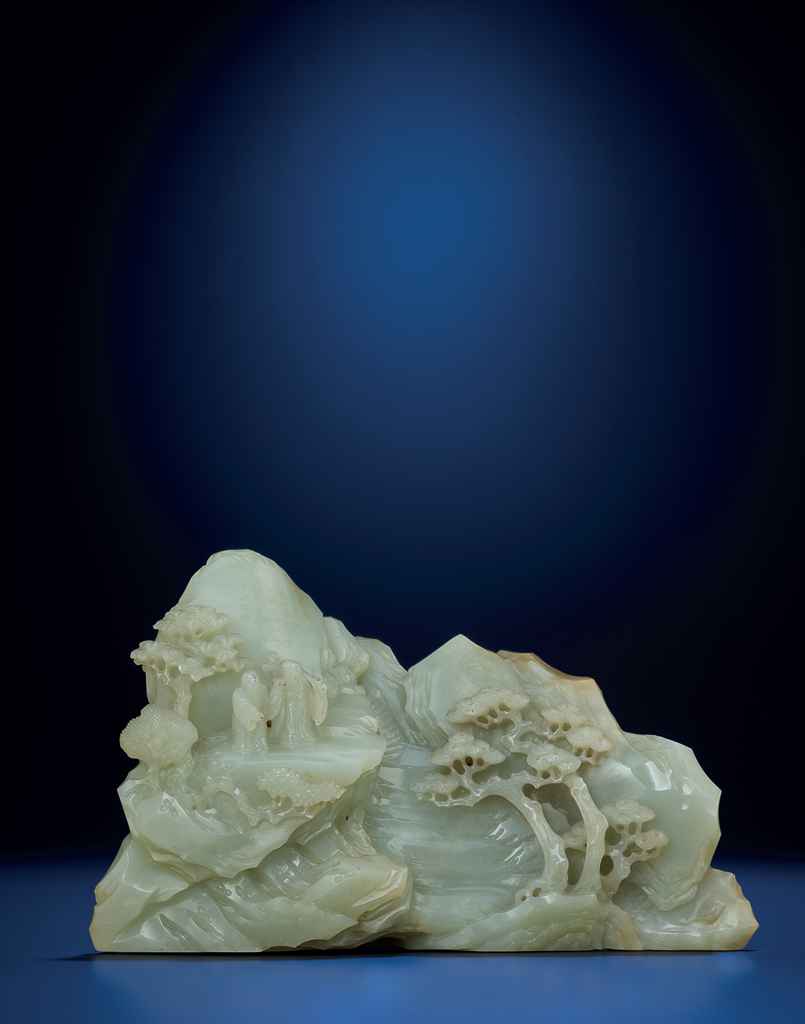
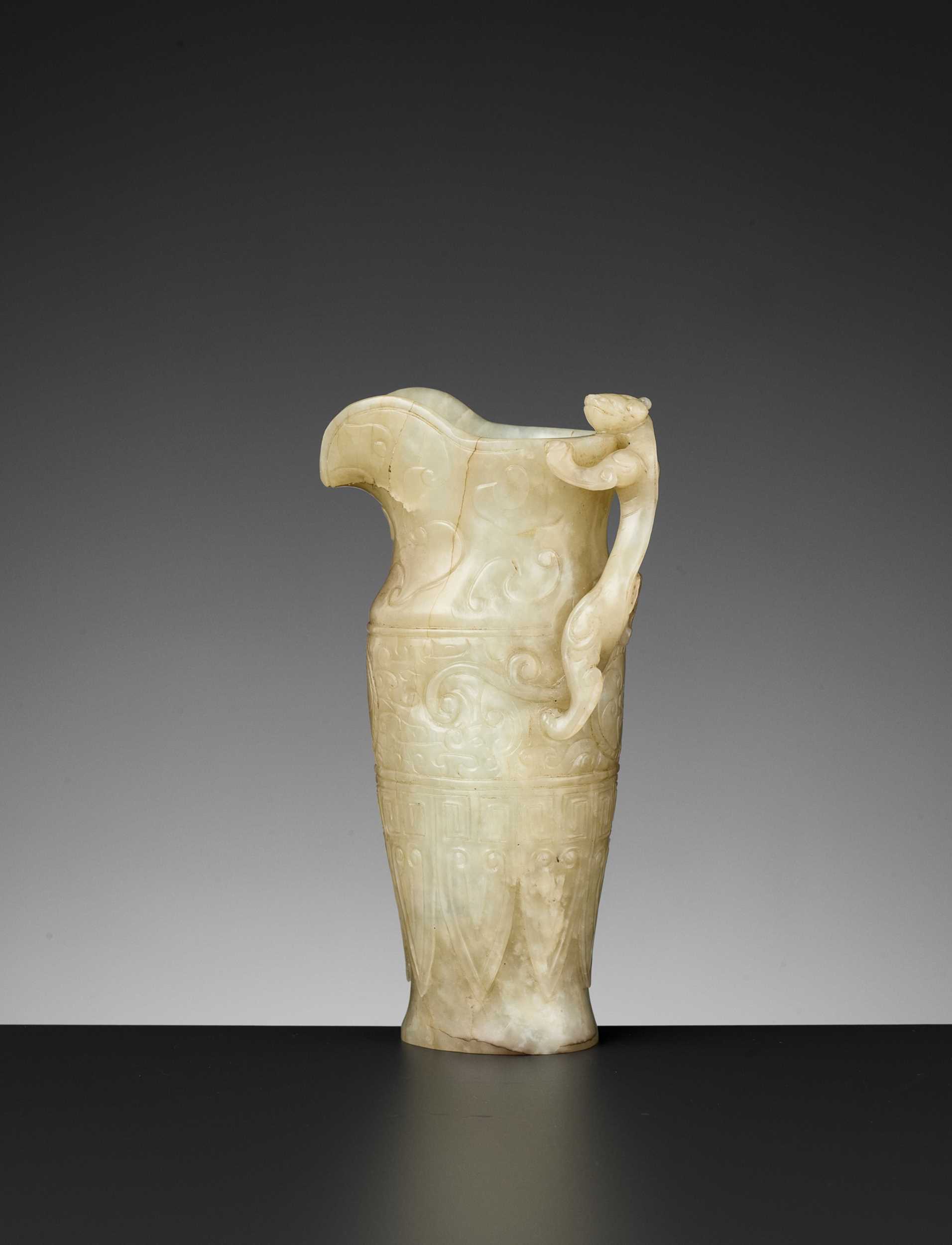

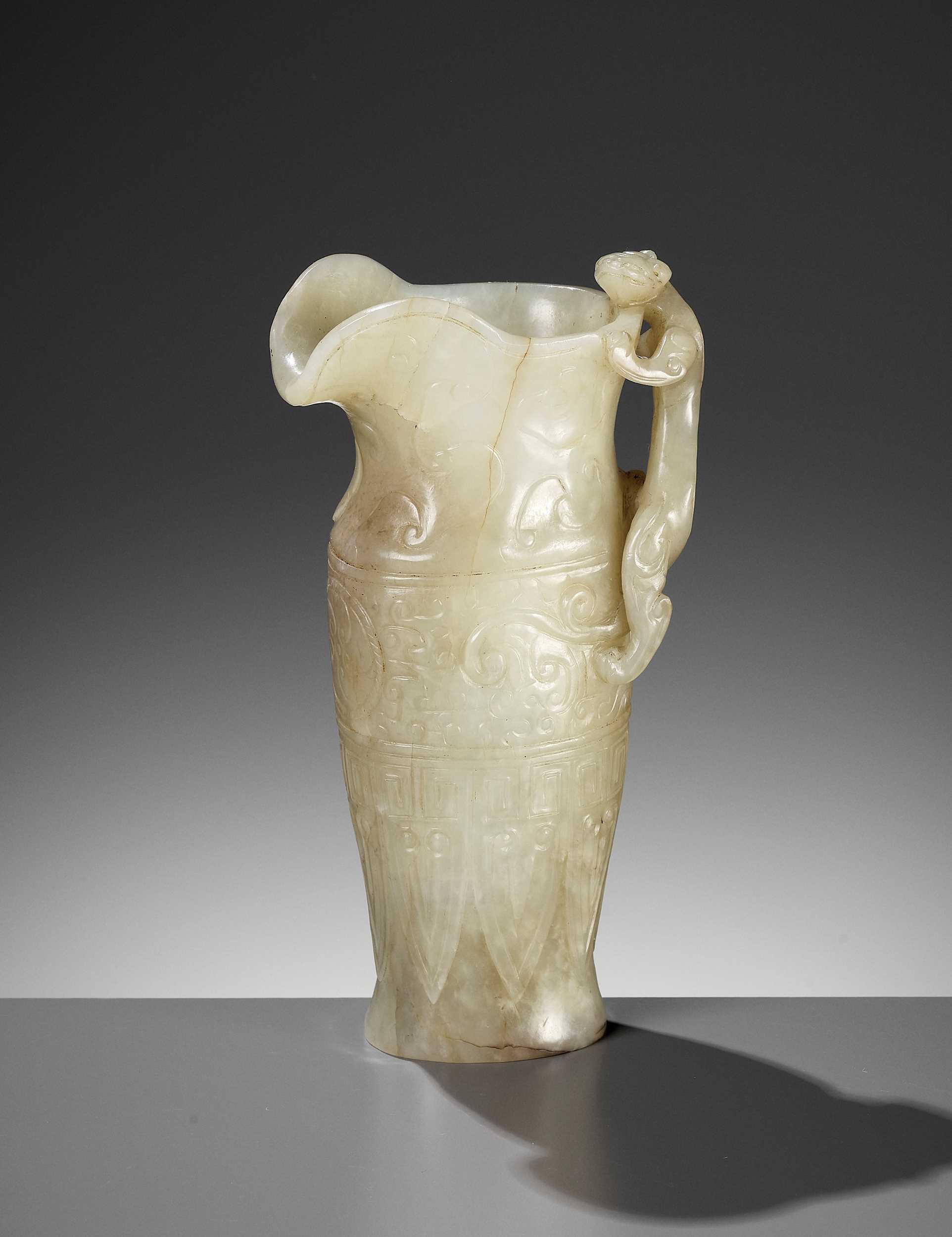


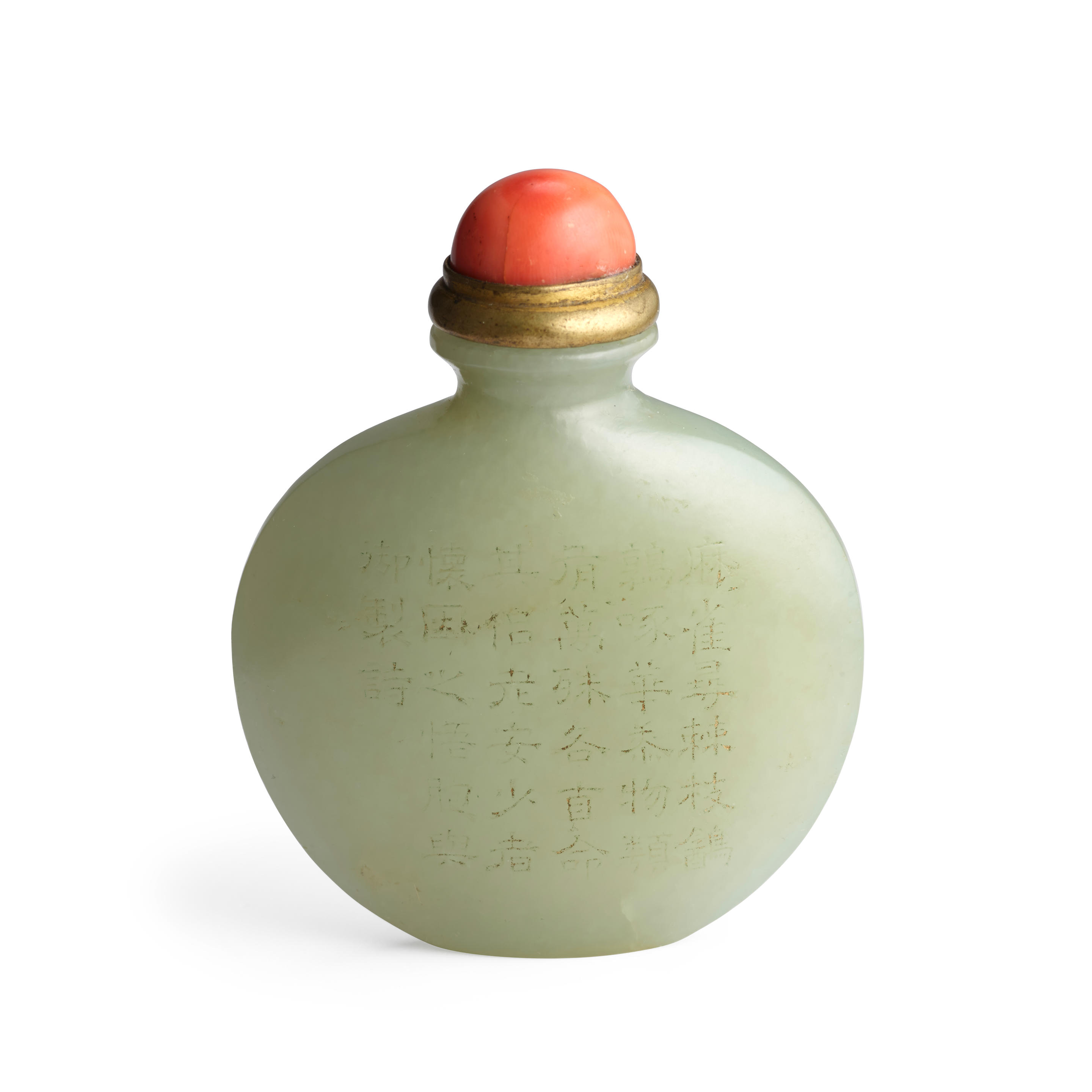



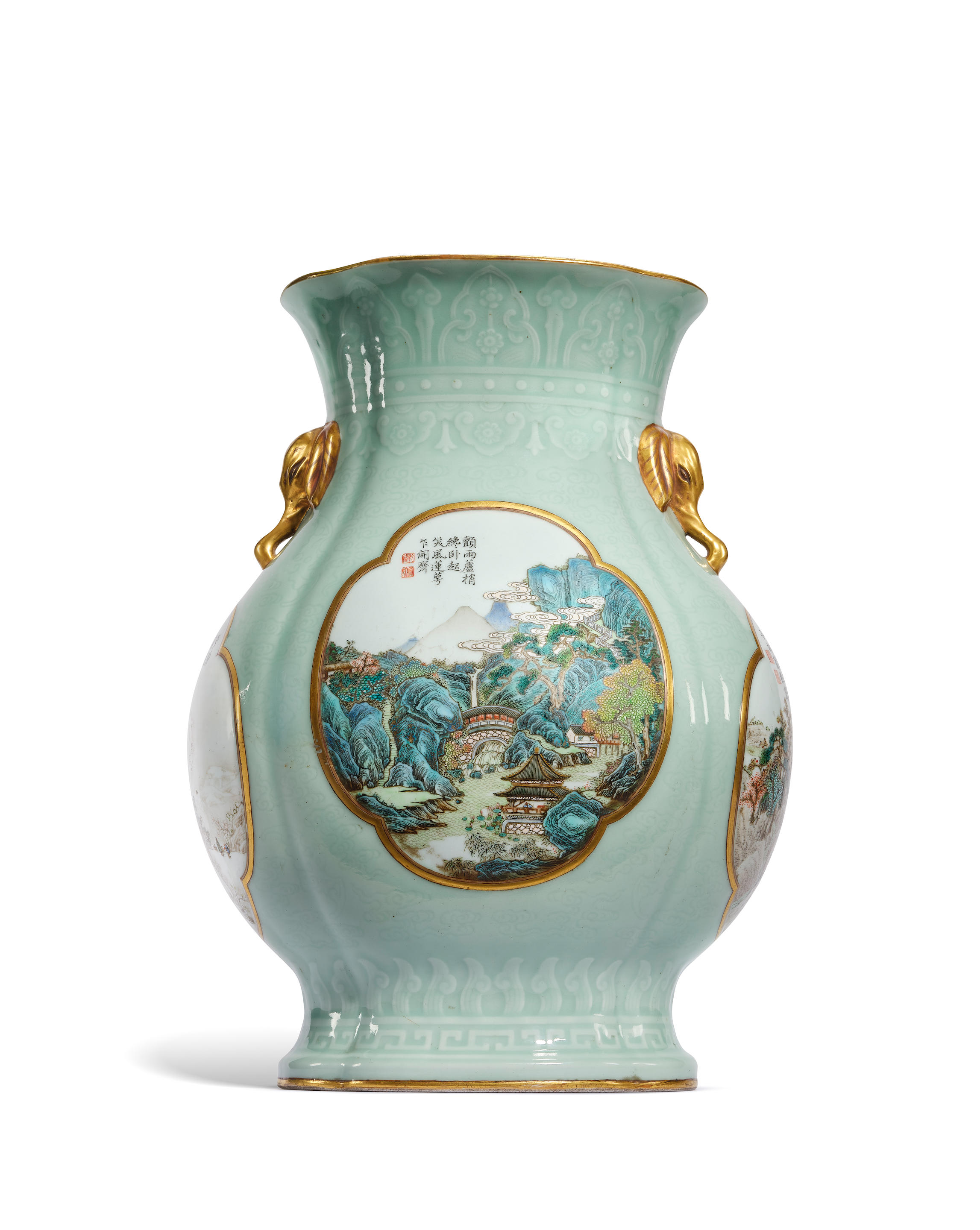

Testen Sie LotSearch und seine Premium-Features 7 Tage - ohne Kosten!
Lassen Sie sich automatisch über neue Objekte in kommenden Auktionen benachrichtigen.
Suchauftrag anlegen